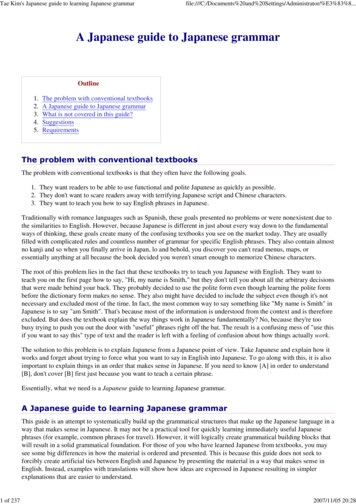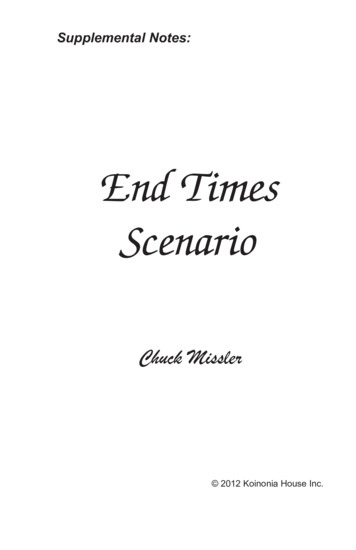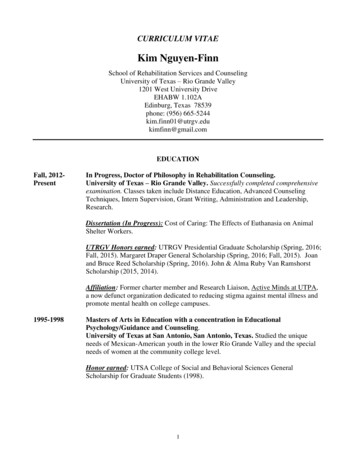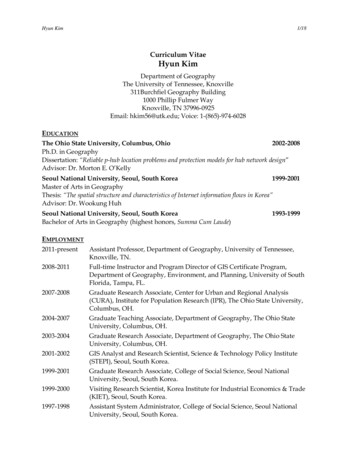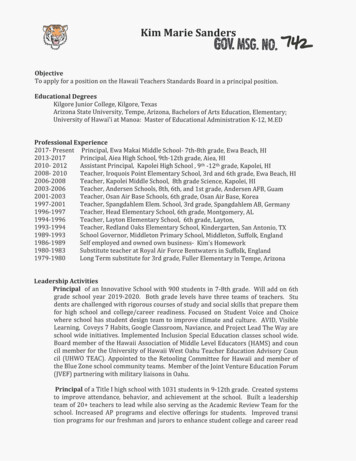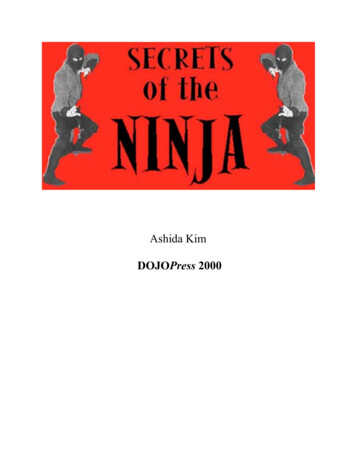
Transcription
Ashida KimDOJOPress 2000
Table of ContentsPreface. . .4Espionage as a Weapon5BASIC NINJITSUMeditation for Inner StrengthKuji Kiri61015INPO- The Art of HidingThe Nine StepsObstacle Course TrainingHiding PlacesCovert EntrySentry RemovalTONPO- The Art of EscapingKumi UchiClouding the MindLeaving No TraceThe s of the NinjaAshida KimAll rights reserved. No portion of this electronic book may be reproduced in any form whatsoever, except for brief passages for the purpose of review, without express written permission ofthe Author and Publisher. The Author and Publisher assume no responsibility nor liability forthe use or misuse of any information contained in this manuscript.Copyright 1981 by Ashida KimDOJO Press 2000 Electronic EditionISBN 0-87364-234-1
PrefaceNinja were the Ultimate Warriors of feudal Japan. Cloaked in darkness and secrecy, theGhost-Soldiers of the Invisible Fist struck fear into the hearts of their enemies and wreakedhavoc on those who incurred their wrath. The principles of these occult methods have notchanged and apply even today.The principles and forms presented herein are intended for use by a lone individual.Some Ninjitsu ryu (schools) advocate the use of such equipment as shuriken, grapples, shaken,even poisons and firearms. These schools train to use or improvise any weapon that may furtherthe objective of the mission. There is much to be said for this approach, even among the schoolsthat practice invisibility such as the Black Dragon Ryu, Therefore, sections explaining the classical Ninja weapons are included.Yet, study of this Art does not require weapons of any sort. Sensei (teacher) once said,"A naked man, alone, in an empty room, can practice Ninjitsu." One cannot move quickly andsilently when encumbered by various tools. And, if captured, these devices would certainly beconfiscated. What is one to do then?Here then are the means to be invisible in the presence of the enemy, to penetrate unseenanywhere, and to pass without leaving a trace.This is the Silent Way of the Mystic-Knights, the Moonlit Path of the Shadow-Warrior,the Invisible Assassins of Feudal Japan, the NINJA.The beauty of these techniques is that they do not require a lifetime to master. Manywere developed by victims who were tired of being bullied but lacked the physical resources toovercome the forces opposing them. Few people have such resources or the time to acquirethem. But, there are bullies aplenty. The student need only learn one technique and have thecourage to carry it out to free himself of oppression. Making war is not hard, keeping the peaceis hard. That is why the Ninja, who value peace and harmony above all else, have gone to suchgreat lengths over many centuries to canonize and preserve these methods. And why, because itis so simple, the techniques have often been turned to revenge or used to raise and armyquickly. When there is no justice, the Ninja appear. They are not “called to action” by anyone.They are just ordinary people in extraordinary situations. They need not have a “clan” or“credentials” or even a great deal of training. They only need the Will.The Ninja do what must be done, then it is forgotten. Princes and kings may gain sometemporary advantage through Force. But, the only lasting accomplishments are achievedthrough Love.This is the true lesson of Ninjitsu3
Espionage as a WeaponAbout five hundred years before the birth of Christ, a Chinese philosopher named SunTse stated in his "Rules for Political and Psychological Subversion" that, "there is no art higherthan that of destroying the enemy's resistance without a fight on the battlefield. According tothis sage,"The direct tactic of war is necessary only on the battlefield, but only the indirect tacticcan lead to a real and lasting victory.“Subvert anything of value in the enemy's country. Implicate the emissaries of the majorpowers in criminal undertakings; undermine their position and destroy their reputations in otherways as well; and expose them to the public ridicule of the their fellow citizens.“Do not shun the aid of even the lowest and most despicable people. Disrupt the work oftheir government with every means you can.“Spread disunity and dispute among the citizens of the enemy's country. Turn the youngagainst the old. Use every means to destroy their arms, their supplies, and discipline of the enemy's forces.""Debase old traditions and accepted gods. Be generous with promises and rewards topurchase intelligence and accomplices. Send out your secret agents in all directions. Do notskimp with money or with promises, for they yield a high return."It is upon this passage from the Art of War that Japanese Ninjitsu is based.Sun-Tse was quite correct. No more need be said concerning espionage as a weapon.But, The Art of Invisibility is far older even than this. Nor was Sun-Tse the first to recognize this principle. And, much later, Macheivelli's The Prince expressed the same sentimentwith regard to conquering new lands. The great expense of war being his primary motivation incounseling the medieval lords of his time.4
Basic NinjitsuThe origins of Ninjitsu are shrouded in the mists of time. It was greatly influenced byChinese spying techniques, many of which are found in Sun-Tse's classic, The Art of War. Theword Ninjitsu itself originated during a war between Prince Shotoku and Moriya over the landof Omi in sixth century Japan. During this conflict, a warrior named Otomo-no-Saajin contributed to the victory of Prince Shotoku by secretly gathering valuable intelligence about the enemy forces. For this service, he was awarded the title of Shinobi, which means "stealer in."From this ideogram, the character for the word Ninjitsu is derived.Originally, the role of the Ninja was to gain information about the enemy and to sabotage his operations. Agents were classified as: Indigenous, meaning local personnel who gathered intelligence or worked for the Ninja on site; Sleeper, being one long in place, merelyawaiting instructions; Doubled or Turned, a former agent of the enemy who spied for bothsides; and Expendable agents who were used for only one mission and then left to fend forthemselves. Such agents include both men and women, the female Ninja were called Kunoichiand carried out missions of assassination and sabotage, as well as espionage.Ninjitsu is not a magical technique which will enable you to disassemble your body andreassemble yourself somewhere else. It will not change the structure of your body, making ittransparent. This Art of Invisibility consists of the skills employed to make yourself unseeable;in this context, the art becomes almost a philosophy.The ancient masters have said, "A tree falling in the forest with no one to hear it, makesno sound; but, it falls nonetheless." So it is with Ninjitsu. A Ninja attacking a blind man is invisible, but he is attacking nonetheless.5
To Be A NinjaTo be a Ninja, indeed to even contemplate the Silent Way, one must be a hunter. Thismeans that he knows the ways of his prey. He studies their habits, patterns of movement, androutines. In this way, he can strike when they are most vulnerable, or trap them in their ownhabits.To be a Ninja, an invisible assassin, one must be a warrior. This means that he acceptsresponsibility for his actions. Strategy is the craft of the warrior.To be a Ninja, one must be a wizard. This means that he can "stop the world" and "seewith the eyes of God." This is the essence of Mugei-Mumei No-Jitsu, which is translated tomean, "no name-no art." Secrecy is the hallmark of being a spy.To be a Ninja, one must be strong, one must know, one must dare, and one must be silent.Uniform of the NinjaThe costume of the Ninja is basically that of the stage handlers of the Kabuki theatre,who sneak on stage during scenes to help actors with costume changes, move scenery, or remove props. He is not noticed, even though he may remain in full view for an entire act. Heseems a part of the landscape. And, when he does move, it is accomplished so swiftly and unobtrusively that he escapes notice. This symbolism applies equally to the actions of an agent in thefield.For our purposes, the Ninja uniform consists of: (a) Black Ski Mask, as camouflagepaint or "blacking" of the face is time consuming and cannot be quickly removed. (b) Blackoverjacket, often reversible to disguise the appearance. (c) Black Belt or sash. (d) Black Coveralls, with blousing ties at the wrists, elbows, knees, and ankles. And, (e) Black Tabi, split toedsocks made for wearing with sandals. The soft sole of these protects the feet and helps mufflethe sounds of walking.The traditional uniform also included the hakima which is a divided skirt for formalwear, leggings, and a light tunic of chain mail. My Sensei also employed a large, gray, hoodedcape which was used to distort the silhouette, a true "cloak of invisibility."The costume of the Ninja was called Shinobi Shokozu. The blousing ties at the jointscould serve to slightly numb the body to take impact in hand to hand combat by tightening themslightly. Or, as tourniquets to stop bleeding if the agent were slashed during swordplay.Black is considered the "traditional" color because it was used by the Kabuki stage handlers. Theatregoers were expected to ignore the "shadow" figure, who used many of the sametechniques employed today for espionage, to move invisibly about the stage. But, solid black"stands out" at night among the true shadows cast by moon and torchlight. Therefore, mostNinja schools used brown, gray, or red uniforms.Red had the advantage of being black at night, with no sunlight to reflect the crimsoncolor; a fact known only to those who studied light and shadow as a Neolithic science. When itcame into the firelight, however, the color returned. And psychologically intimidated the enemythrough the association of red with the fear of blood.6
This trick was also used by the Spartans of ancient Greece, who wore red capes tofrighten the enemy and conceal any wounds they might receive in battle. An example of Saimenjitsu (Hsi Men Jitsu) the Way of the Mind Gate. Ninja terminology for the study of themind, psychology.Again, an example of "powers and abilities far beyond those of mortal man." Most ofwhom were still living in mud huts at this period of human history. Cooking on open fires,struggling to eke out an existence with primitive agriculture, no medicine to speak of by modern standards, it is difficult to believe that in such times men had time to oppress each other andwage war. But, it has always been thus.Only the Ninja stood between the peasants and the princes. Only they could passthrough walls and strike at the heart of the enemy camp. That is why it is forbidden to use thisArt for personal gain. That is why it is full of hidden philosophical lessons. In this way theNinja is protected by the armor of righteousness, and can do no wrong.Principles of Light and ShadowSince any opaque object absorbs light, it produces a shadow in the space behind it. If thesource of light is a point, an opaque surface cuts off all light striking it, producing a shadow ofuniform density. An example is the casting of hand shadows on a wall.If the source of light is larger than a point, the shadow varies in intensity, creating theumbra and penumbra. The former is that portion from which all rays of light are obscured,while the penumbra is the lighter part, not entirely hidden from the observer.Spotlights, hand torches, and so on, are points of light. The latter of the two shadows isthe more frequently encountered. Thus, in Ninjitsu, we strive to remain in the deepest shadow,the umbra, as this offers the best concealment.The rule of Kagashi-no-jitsu states that the eye sees movement first, silhouette second,and color third. Dark adaptation means allowing the eyes to become accustomed to low levelsof light. Approximately thirty minutes are required for the rod cells of the eye to produce sufficient visual purple to enable the eye to distinguish objects in dim light. Off Center vision is atechnique of focusing attention on an object without looking directly at it. When an object islooked at directly, the image is formed on the cone region of the eye. This area is not sensitiveat night. When the eye looks five to ten degrees above, below, right, or left of the object, theimage falls on the rod cells, making it visible in dim light.Scanning is a method of using this off-center vision to observe an object or area. Duringnight observation, the visual purple of the rod cells bleaches out in five to ten seconds and theimage fades. As this occurs, you must shift the eyes slightly so that fresh rod cells are used.Move the eyes in short, irregular intervals over the object, but do not look directly at it.Pause a few seconds at each point of observation because your eyes normally are used wherethere is sufficient light to create sharp outlines and bright colors. In darkness, objects are faint,have no distinct outline, and little or no color. To move in darkness, you must believe what yousee. Only practice can achieve this.7
At night, if the enemy can be seen, keep the fire (light) between yourself and the enemy.Remember, the enemy is looking from and area of light (in which his pupils have constricted)into an area of darkness, where insufficient light exists to display an image on the cone regionof the retina. In daylight, keep the fire and the door on your right, and keep the left side clear.Moving in shadows requires that a path be selected from one place of concealment toanother, crossing any exposed areas quickly and quietly Standing in darkness requires great patience and controlled breathing. The best place inside a room is the nearest corner behind thedoor. Select a shadow to be used and advance silently to it. Assume a posture which conformsto the shape of the shadow and remain within it. Pr
Ninja is protected by the armor of righteousness, and can do no wrong. Principles of Light and Shadow Since any opaque object absorbs light, it produces a shadow in the space behind it. If the source of light is a point, an opaque surface cuts off all light striking it, producing a shadow of uniform density. An example is the casting of hand shadows on a wall. the and . The . DOJO Press 2000 .File Size: 1MBPage Count: 85

